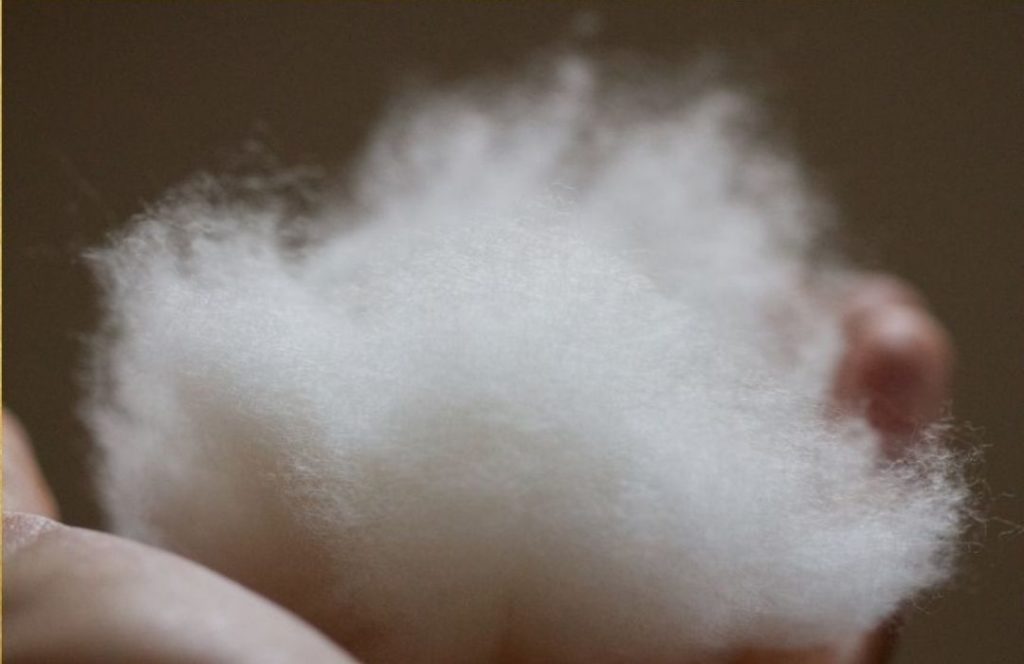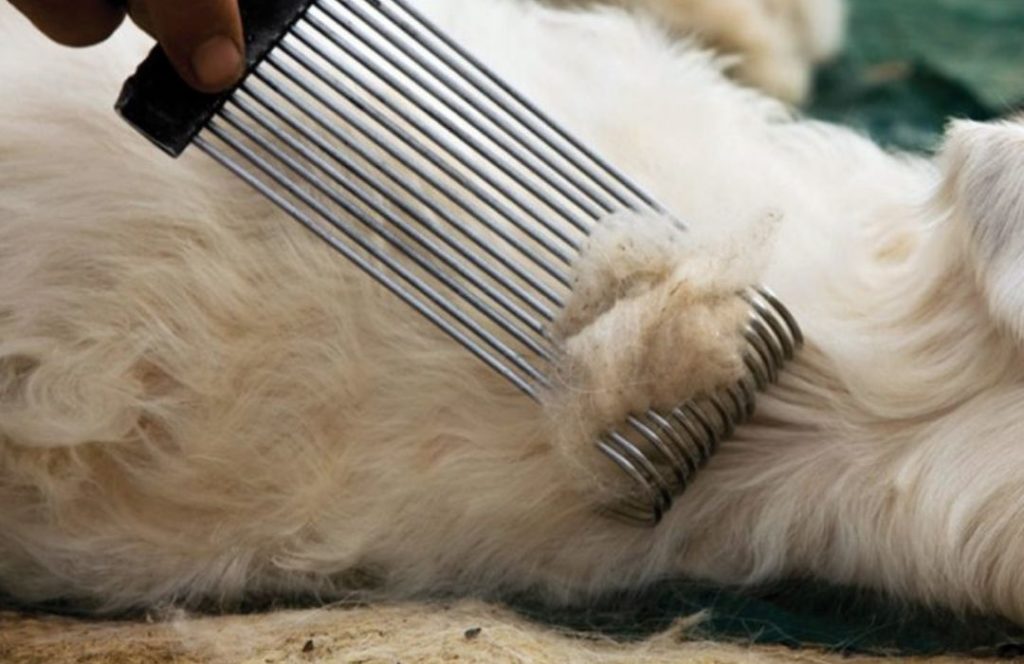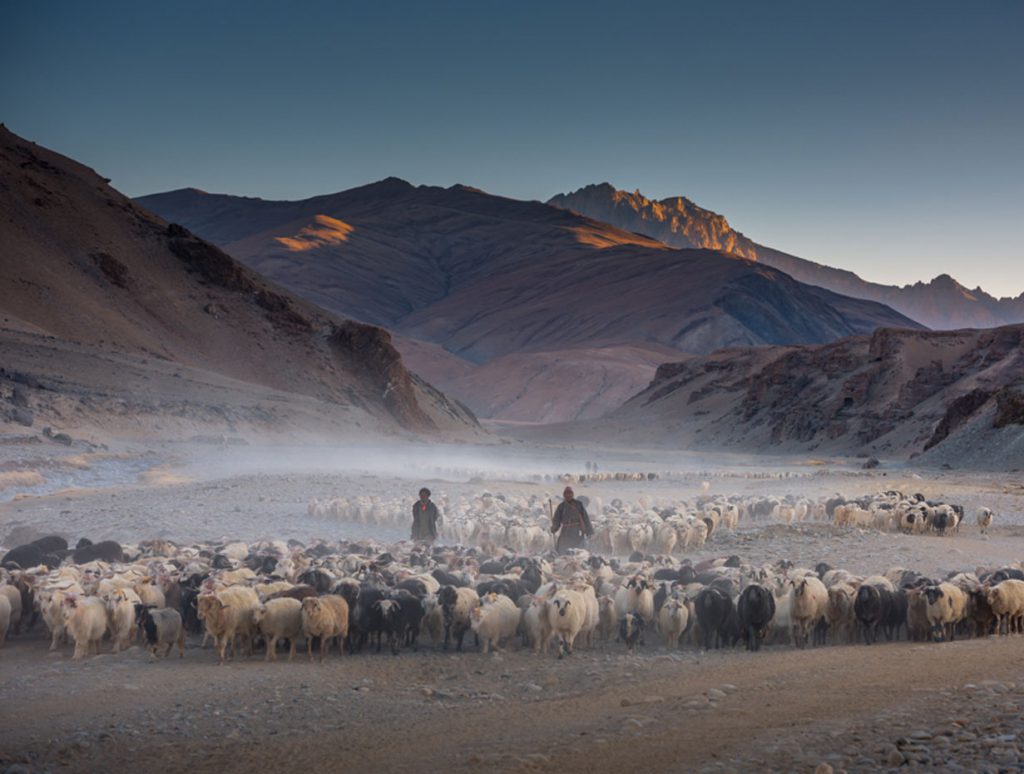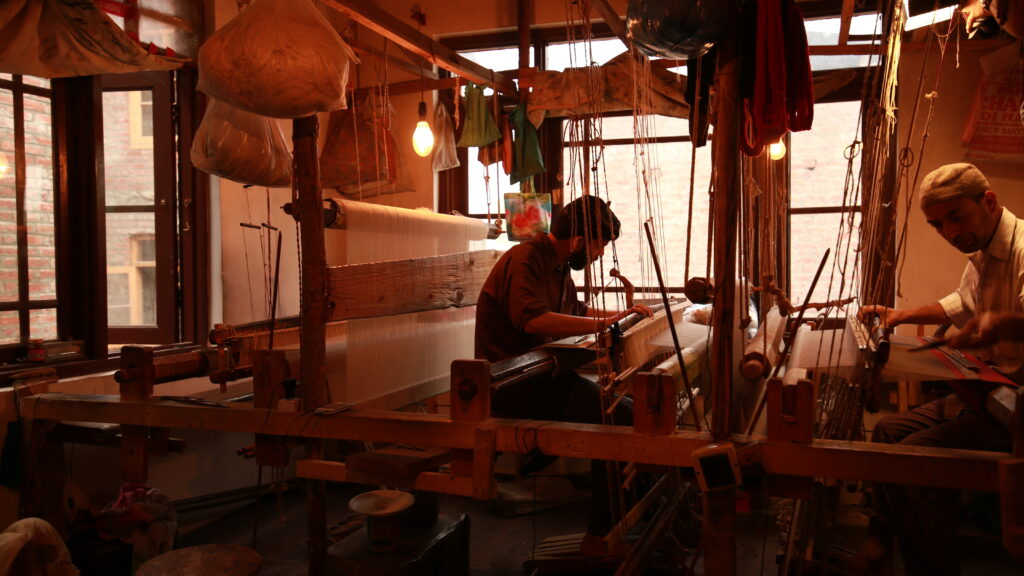Pashmina, the name stands as a pinnacle of luxury in the world of textiles. Artisans craft exquisite Pashmina wraps and scarves, famous for their unparalleled softness and warmth, from the fine undercoats of the Changthangi goats. The goats are native to the high-altitude regions of Ladakh in India and grow Cashmere wool as an undercoat. And, it is the process of converting this raw cashmere wool into luxurious Pashmina shawls, scarves, and wraps that is a true art form. This is because it involves meticulous craftsmanship and a deep understanding of traditional techniques that pass down through generations.
The significance of Pashmina extends beyond its physical attributes. In modern fashion, Pashmina shawls and scarves are accessories that patrons dream of. This is because they symbolize elegance, sophistication, and timeless beauty. These items are cherished not only for their aesthetic appeal but also for the cultural heritage they embody. In regions like Kashmir and Ladakh, Pashmina holds a revered place in tradition. In fact, it is often an essential part of ceremonies and rituals locally. Additionally, its production supports the livelihoods of many artisans, making it an integral aspect of the socio-economic fabric of these communities.
Ethical Concerns
However, the allure of Pashmina brings with it a need for scrutiny regarding its ethical production. As the global demand for this luxurious fabric grows, concerns about sustainability, fair trade practices, and animal welfare have come to the forefront. This blog aims to delve into these ethical considerations. As such, we will shed light on the practices involved in Pashmina production. Also, we will evaluate their impact on the environment, the well-being of the Changthangi goats, and the lives of the artisans who create these masterpieces.
In exploring whether Pashmina is ethical, we will examine various aspects. We will examine the sourcing of the wool, the treatment of the goats and the labour conditions of the artisans. Also, it is important to check the environmental impact of the production processes. By understanding these factors, consumers can make informed decisions and contribute to a more sustainable and ethical fashion industry. So, let's unravel the layers of this luxurious art and uncover the truth behind the production of Cashmere. Let's ensure that people appreciate the beauty of Pashmina not just for its appearance but for the values it upholds.
What is Pashmina?
Pashmina is an intricate art form that transforms the fine cashmere wool of Changthangi goats into luxurious shawls, scarves, and wraps. The term "Pashmina" comes from the Persian word "Pashm," meaning "soft gold." In fact, this name aptly describes the exquisite quality of the wool and the painstaking craftsmanship involved in creating Pashmina products.
Cashmere Wool vs. Regular Sheep Wool

Cashmere wool is harvested from the undercoats of the Changthangi goats. These goats are native to the high-altitude regions of Ladakh in northern India. This wool is incredibly soft, fine, and warm, distinguishing it from regular sheep wool. Sheep wool fibers are typically thicker and coarser, providing less warmth and a rougher texture. In contrast, cashmere fibers are much finer, often measuring less than 15 microns in diameter, resulting in a fabric that is exceptionally soft and lightweight yet incredibly warm.
The Transformation Process: From Raw Wool to Pashmina
- Harvesting: The process begins with the careful combing of the Changthangi goats during the spring moulting season. This method is gentle and herders make sure to not harm the goats. The raw wool collected is the finest and softest part of the goat's coat.
- Cleaning and Sorting: Firstly, artisans clean the raw wool to remove impurities and sort it based on fiber quality. They use only the finest fibers to create Pashmina, ensuring the highest quality end product.
- Spinning: Secondly, artisans spin sorted fibers into yarn by hand, a process that requires immense skill and patience. The artisans use traditional spinning wheels to create yarn that is both strong and delicate.
- Weaving: Subsequently, weavers weave the spun yarn into fabric using handlooms. This process is labour-intensive and time-consuming, often taking several days to complete a single piece. The weaving process is where the true artistry of Pashmina comes to life, as artisans create intricate patterns and designs.
- Embellishing: Many Pashmina products are further embellished with embroidery, adding to their beauty and value. Skilled artisans hand-embroider the fabric, often using traditional motifs and techniques passed down through generations.
- Finishing: Finally, its washing time. Washing and finishing the fabric to enhance its softness and lustre. This includes processes like blocking and pressing to ensure the shawls and scarves drape perfectly.
Traditional Regions of Pashmina Production
Pashmina has deep roots in the regions of Kashmir and Ladakh. Kashmir, in particular, is famous for its exquisite Pashmina shawls, often referred to as "Kashmiri Pashmina". The art of Pashmina weaving has been an integral part of Kashmiri culture for centuries. Artisans have dedicated their lives to mastering this craft. Ladakh, with its harsh climate and high-altitude terrain, provides the ideal environment for the Changthangi goats, whose wool forms the foundation of Pashmina.
In these regions, Pashmina production is not just an economic activity but a way of life. The skills and techniques required to create Pashmina pass down through generations, preserving the cultural heritage and traditions of these communities. Each Pashmina product is a testament to the dedication and craftsmanship of the artisans, making it a truly unique and valuable piece.
Understanding the intricate process and cultural significance behind Pashmina enhances our appreciation of this luxurious fabric. It also underscores the importance of ethical and sustainable practices in preserving the art of Pashmina for future generations.
Ethical Sourcing of Cashmere Wool
The ethical sourcing of Cashmere wool is a crucial aspect of Pashmina production. This luxurious fiber comes from the Changthangi goats, which are native to the high-altitude regions of Ladakh in northern India. Ensuring that these animals are treated with care and that the environmental impact of their herding is minimized are central concerns for maintaining ethical standards in Pashmina production. So, is Pashmina ethical? Let's explore the details.
Sourcing Cashmere Wool from Changthangi Goats

Changthangi goats, also known as Pashmina goats, produce one of the finest and softest wools in the world. Herders harvest the wool during the spring moulting season when the goats naturally shed their winter coats. This process involves gently combing the undercoat of the goats to collect the fine fibers. This method is humane and herders make sure to treat the goats humanely, as the wool is naturally ready to be shed. Unlike some industrial practices that can involve shearing or less humane methods, the traditional combing process is respectful to the animals.
Living Conditions and Treatment of the Goats
The Changthangi goats live in harsh, high-altitude environments where temperatures can drop significantly. These conditions are ideal for producing the fine undercoat that is the most valuable in Pashmina production. Local herders ensure that the goats are well, providing them with necessary shelter, food, and water. The well-being of these goats is crucial, as healthy goats produce the highest quality wool. Ethical practices dictate that the goats should live in their natural habitats, where they can graze freely and lead healthy lives.
Environmental Impact of Goat Herding and Grazing Practices

Goat herding and grazing practices can have a significant environmental impact, particularly in fragile ecosystems like those found in Ladakh. Overgrazing by goats can lead to soil erosion and degradation of vegetation, which in turn affects the local biodiversity. To address these concerns, sustainable herding practices are essential. These practices include rotational grazing, which allows vegetation to recover, and maintaining a balanced number of goats to prevent overgrazing.
Local communities and organizations are increasingly aware of the need to balance the economic benefits of Pashmina production with environmental conservation. They are making efforts to educate herders about sustainable grazing practices and to implement measures that protect the local environment.
Sustainability of Wool Collection Methods
The wool collection methods used in Pashmina production are designed to be sustainable. The natural moulting process of the Changthangi goats ensures that the wool is ready to be harvested without causing harm to the animals. This process is inherently sustainable, as it aligns with the goats' natural lifecycle.
Additionally, many initiatives are focused on supporting ethical sourcing by providing training and resources to herders. These initiatives help ensure that the goats are treated well and that the environmental impact of herding is minimized. They also promote fair trade practices, ensuring that herders receive fair compensation for their wool, which supports local economies and contributes to the overall sustainability of Pashmina production.
So, is Pashmina ethical? The answer largely depends on the practices employed in its production. Ethical Pashmina production involves humane treatment of goats, sustainable grazing practices, and fair compensation for herders. By supporting such practices, consumers can contribute to a more sustainable and ethical fashion industry. One can ensure that the beauty of Pashmina remains preserved for future generations while respecting both animal welfare and environmental integrity.
Fair Trade and Labour Practices

The production of Pashmina involves skilled artisans who dedicate countless hours to creating these luxurious items. To truly understand the ethical implications of Pashmina, it's important to look at the working conditions of these artisans, the economic benefits they receive, and the role of fair trade practices in ensuring their well-being. Is Pashmina ethical? Let’s delve into the details.
Working Conditions of Pashmina Artisans
Pashmina artisans typically work in small, family-run workshops or community cooperatives. These artisans often inherit their skills through generations, making Pashmina weaving a deeply rooted cultural tradition. However, the conditions under which they work can vary significantly. In ethical production setups, artisans have access to safe and clean working environments, proper lighting, and the tools necessary for their intricate work. These conditions are crucial for maintaining their health and ensuring high-quality craftsmanship.
Fair Wages and Economic Benefits for Local Communities
One of the core principles of fair trade is ensuring that workers receive fair wages. In the context of Pashmina production, fair wages mean that artisans are compensated in a way that reflects the skill and time required for their craft. Unfortunately, many artisans in the Pashmina industry have historically been underpaid, leading to economic hardships.
Ethical Pashmina brands and cooperatives aim to change this by ensuring that artisans receive fair wages that enable them to support their families and improve their quality of life. When artisans are paid fairly, the economic benefits extend beyond individual households to entire communities. Subsequently, increased income can lead to better access to education, healthcare, and other essential services.
Role of Cooperatives and Organizations Promoting Fair Trade Practices
Cooperatives play a significant role in promoting fair trade practices within the Pashmina industry. These organizations bring artisans together, providing them with a collective voice to negotiate better wages and working conditions. Cooperatives also offer training and resources to help artisans improve their skills and product quality.
Organizations like Fair Trade International and the World Fair Trade Organization work to certify Pashmina producers who adhere to fair trade principles. These certifications ensure that consumers can trust that the Pashmina products they purchase have been made under ethical conditions.
So, is Pashmina ethical? The answer depends largely on the practices of the producers. By supporting fair trade in Pashmina, consumers can help ensure that artisans work in safe conditions, receive fair wages, and contribute to the economic development of their communities. Ethical Pashmina production not only preserves the cultural heritage of this ancient craft but also empowers the artisans who create these exquisite pieces.
Environmental Impact
The production of Pashmina, while cherished for its luxurious qualities, also has environmental implications that people need to manage carefully. Understanding the environmental footprint of Pashmina production involves looking at both the positive and negative impacts, as well as the sustainable practices that many have adopted to mitigate these effects.
Environmental Footprint of Pashmina Production
The environmental footprint of Pashmina production begins with the herding of Changthangi goats, which are native to the high-altitude regions of Ladakh. These goats require extensive grazing areas, and their herding can lead to overgrazing and soil erosion if not properly managed. Overgrazing can degrade the land, affecting local biodiversity and the overall health of the ecosystem.
Additionally, the traditional processes of Pashmina production, such as washing, dyeing, and finishing the wool, can consume significant amounts of water and energy. The use of chemical dyes can also pose risks to both the environment and the health of the workers if not handled properly.
Sustainable Practices in Pashmina Production
To address these environmental concerns, many have adopted several sustainable practices within the Pashmina industry. One key practice is the use of eco-friendly dyes. These dyes are made from natural sources and are biodegradable, reducing the pollution associated with chemical dyes. They also require less water for dyeing, helping to conserve this precious resource.
Waste minimization is another crucial aspect of sustainable Pashmina production. Artisans and manufacturers are increasingly focusing on reducing waste throughout the production process. This includes reusing water in the dyeing process, recycling waste fibers, and ensuring that any by-products are disposed of in an environmentally friendly manner.
Comparison with Synthetic Fibers
When compared to synthetic fibers, the environmental impact of Pashmina is significantly lower. Synthetic fibers like polyester and nylon come from petroleum, a non-renewable resource. Their production involves high energy consumption and the release of harmful greenhouse gases. Moreover, synthetic fibers contribute to microplastic pollution, as they shed tiny plastic particles during washing, which then enter water bodies and harm aquatic life.
In contrast, Cashmere is a natural fiber that is biodegradable and renewable. The traditional methods of producing Pashmina, though energy-intensive, are being adapted to be more sustainable, which helps to further reduce its environmental footprint.
So, while Pashmina production does have an environmental impact, there are numerous sustainable practices and initiatives aimed at mitigating these effects. By adopting eco-friendly dyes, minimizing waste, and supporting sustainable grazing practices, the Pashmina industry is working towards a more environmentally conscious future. As consumers become more aware of these efforts, they can make informed choices that support both the environment and the artisans who create these beautiful products.
Animal Welfare Considerations
Animal welfare is a crucial aspect of the Pashmina production process. The ethical treatment of Changthangi goats, from which Cashmere wool is sourced, directly impacts the quality of the wool and the sustainability of the industry. When considering the question, "Is Pashmina ethical?", it is important to explore how these animals are treated and what measures are taken to ensure their well-being.
Ethical Treatment of Changthangi Goats
Changthangi goats, also known as Pashmina goats, are native to the high-altitude regions of Ladakh. These goats are well-adapted to the harsh climatic conditions of the Himalayas, where they produce the fine undercoat that is used to make Pashmina. Ethical treatment of these goats involves providing them with adequate food, shelter, and veterinary care. Goatherds must ensure that the animals are not overburdened or mistreated and that their natural behaviours are respected.
Potential Issues Related to Animal Welfare
One of the primary concerns related to animal welfare in Pashmina production is the potential for overexploitation. In some cases, the demand for Cashmere wool can lead to practices that prioritize quantity over quality, resulting in poor living conditions for the goats. This includes insufficient grazing land, lack of proper nutrition, and inadequate medical care. Overgrazing by large herds can also degrade the environment, affecting the health of the goats and the sustainability of the ecosystem.
Another issue is the physical process of collecting the wool. The traditional method involves combing the goats to remove the fine undercoat, which can be stressful for the animals if not done gently and at the right time of year. Harsh or rushed combing practices can cause discomfort or injury to the goats.
Practices Ensuring Humane Treatment
To address these concerns, several practices are in place to ensure the humane treatment of Changthangi goats. Ethical Pashmina producers adhere to guidelines that promote animal welfare, such as:
- Sustainable Grazing: Implementing rotational grazing systems to prevent overgrazing and ensure that the goats have access to fresh, nutritious forage. This helps maintain the health of the goats and the land.
- Adequate Veterinary Care: Providing regular veterinary check-ups and treatments to prevent and address any health issues. This includes vaccinations, parasite control, and proper nutrition.
- Gentle Wool Collection: Ensuring that herders collect the wool during the natural shedding season using gentle combing techniques. This minimizes stress and discomfort for the goats. Training herders in proper combing methods is crucial to maintaining animal welfare.
Is Pashmina ethical? The answer depends on the practices of the producers. By prioritizing the welfare of Changthangi goats, ethical Pashmina producers can ensure that herders acquire the wool in a humane and sustainable manner. Consumers can support these practices by choosing Pashmina products from certified ethical sources, thereby promoting a more compassionate and responsible Pashmina industry.
Consumer Awareness and Responsibility
As consumers become increasingly conscious of the ethical and environmental implications of their purchases, it's essential to understand how to identify and support ethically produced Pashmina. By making informed choices, consumers can ensure they are buying products that adhere to high standards of animal welfare, fair trade, and sustainability. Here are some tips and resources to help consumers make responsible choices.
Tips for Identifying Ethically Produced Pashmina
- Research the Brand: Before purchasing Pashmina, take the time to research the brand. Ethical brands often provide detailed information about their sourcing practices, the treatment of animals, and the working conditions of their artisans. Transparent brands commit to ethical practices.
- Ask Questions: Don't hesitate to ask questions when purchasing Pashmina. Inquire about how the wool is sourced, the conditions under which the goats are kept, and the treatment of artisans involved in the production process. Ethical retailers will be open and willing to share this information.
- Look for Handmade Products: Often, artisans produce handcrafted Pashmina products ethically. Artisans who create these items often work in small cooperatives or family-run businesses that prioritize quality and ethical practices over mass production.
- Beware of Low Prices: While it's possible to find affordable Pashmina, be cautious of prices that seem too good to be true. Extremely low prices may indicate that the product is not genuine Pashmina or that manufacturers produced it under unethical conditions. Authentic Pashmina, given its labor-intensive production process, will have a higher price point.
Supporting Brands and Organizations Committed to Ethical Practices
Consumers have the power to drive change by supporting brands and organizations committed to ethical practices. When purchasing Pashmina, consider choosing brands that prioritize sustainability, fair trade, and animal welfare. By doing so, you not only get a high-quality product but also contribute to the well-being of the artisans and animals involved in its production.
Resources and Platforms for Purchasing Ethical Pashmina
Here are some resources and platforms where you can find ethically produced Pashmina products:
- Fair Trade Certified Shops: Websites and stores that carry Fair Trade-certified products are a reliable source for ethically produced Pashmina. They ensure that the products meet rigorous standards for fair labour practices and sustainability.
- Ethical Fashion Platforms: Platforms like Made Trade, Accompany, and The Ethical Silk Company offer a range of ethically produced fashion items, including Pashmina. These platforms curate products from brands committed to ethical practices.
- Artisan Cooperatives: Look for Pashmina products made by artisan cooperatives. These cooperatives often adhere to traditional methods and prioritize the well-being of their members and animals. Purchasing directly from cooperatives ensures that a larger portion of the proceeds goes to the artisans.
- Local Ethical Boutiques: Many local boutiques focus on ethical and sustainable fashion. These stores often source their products from ethical brands and provide detailed information about the origins of their items.
By following these tips and supporting ethical brands, consumers can play a significant role in promoting sustainable and humane practices in the Pashmina industry. Your choices matter. And, by making informed decisions, you can help ensure that Pashmina production remains a responsible and ethical craft.
Also read:
9 surprising facts about Kashmiri Shawls
Conclusion: Is Pashmina Ethical?
We have explored the various aspects that contribute to the ethical production of Pashmina. From the humane treatment of Changthangi goats and the sustainable sourcing of cashmere wool to the fair trade practices and the significant role of artisan communities, it is evident that Pashmina can indeed be produced ethically.
The question, "Is Pashmina ethical?" depends on several key factors. First, the ethical treatment of the goats from which the wool is sourced is paramount. Ensuring that these animals live in humane conditions and are not subjected to cruelty is essential for the ethical production of Pashmina. Second, the working conditions and fair compensation for the artisans are crucial. After all, it is them who transform raw cashmere into luxurious Pashmina shawls, scarves, and wraps are crucial. These artisans often rely on this craft for their livelihoods. Hence, fair trade practices help uplift their communities economically and socially.
Environmental considerations also play a vital role in determining "Is Pashmina ethical?" The sustainability of Pashmina production, including the use of eco-friendly dyes and practices that minimize waste and reduce carbon footprints, underscores its potential as an environmentally responsible choice compared to synthetic fibers.
By making informed choices, consumers can support brands and organizations committed to ethical Pashmina production. Look for certifications and labels that indicate adherence to ethical standards. Research the brands you purchase from, and prioritize handmade products that showcase the skill and dedication of artisans. These actions not only ensure that you are buying authentic and ethically produced Pashmina but also contribute to the well-being of the artisans and the preservation of traditional craftsmanship.